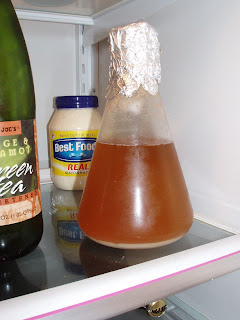I made a 2 pint starter as per White Labs instructions and 24 hours later no activity.....not looking good. I am glad I didnt make a full batch yet! Oh well. not all vials can be a winner. (This is WLP300)
What "activity" are you looking for?
Just like in the fermenter, starter fermentation isn't always dynamic...It doesn't matter one blip in your fermenter or your starter flask if the airlock bubbles or not (if you are using an airlock and not tinfoil,) or if you see a krauzen. In fact starter fermentation are some of the fastest or slowest but most importantly, the most boring fermentations out there. Usually it's done withing a few hours of yeast pitch...usually overnight when we are sleeping, and the starter looks like nothing ever happened...except for the little band at the bottom. Or it can take awhile...but
either way there's often no "activity" whatsoever....
I usually run my stirplate for the first 24 hours, then shut it down, if you are spinning your starter it is really hard to get a krausen to form anyway, since it's all spinning, and there's often a head of foam on it from the movement.
All that really matters is that creamy band o yeast at the bottom.
This is a chilled sample so it's flocculated, but even with an unchilled sample you should see a band of yeast at the bottom.
As it is I've only ever seen two krausens actually on my starter, and the evidence of one on the flask at the "waterline" once. But I've never not had a starter take off.
Now as for the " not all vials can be a winner." comment, I'm going to call shenanagins. Like this thread proves, yeast works more times then most of you new brewers think, it's just doesn't work the way YOU may want or expect it to, or WHEN you expect it to...it's not the yeast fault, it's yours for not just relaxing and giving it enough time.
Of god knows how many batches of beer I have made....
I have never had fermentation not start, or a beer not turn out ok, and I have never ever ever had to add more yeast to a beer.
Except for infecting a starter due to poor sanitization, it really really is hard for yeast NOT to do what they do naturally.
That's how we can make a huge starter from the dregs of a bottle of beer...we let the viable (living) cells reproduce, and we feed them incrementally, and they continue to reproduce.
Seriously most LHBS know enough about what they are doing in terms of proper yeast storage, same with suppliers, it doesn't take a genius these days to know how to stick liquid (and dry yeasts usually) in a fridge, and ship in bulk in a styrofoam cooler.
We're talking billion dollar corporations (the yeast labs, and that's what they are LABS) and they aren't going to risk their rep by letting their suppliers and stores that carry their stuff , handle it improperly.
Besides...Yeast IS hardier than most newish brewers wanna give them props for...I mean You can't say that THIS YEAST was stored "properly" and yet, they managed to make a batch of beer with it.
http://www.wired.com/science/discoveries/magazine/17-08/ff_primordial_yeast
If we can make beer with that....even the tiniest viable glop in a barely smacked pack, is going to work as well.  Gang I can't say this enough;
Unless you bought liguid yeast through the mail in the heat of summer, or added your yeast into boiling wort. your fermentation will happen.
Gang I can't say this enough;
Unless you bought liguid yeast through the mail in the heat of summer, or added your yeast into boiling wort. your fermentation will happen.
Yeast just
don't not work anymore, that is an idea that came from the bad old days before homebrewing was legalized in 1978 when yeast came in hard cakes that travelled in hot cargo holds of ships ...And then sat under the lid of blue ribbon malt extract for god knows how long on grocery stores shelves.
But since 1978 yeast science has been ongoing and the yeasts of today, wet OR dry are going to work in 99.9% of the situations we have, if you give them the time to do so.
But every noob who starts an "my yeast is dead thread" just really pertpetuates a fear that has come from way back then, they got it from Papazain and other brew books written
Thirty or more years ago, and were told horror stories of those yeasts, and it influenced their writing, which influence nervous noob brewers as well. AND he influenced Palmer and other book writers, who passed that yeast doubt onto generations of brewers.
And then, most of the time, you new brewers then freak each other out!!!! You see an "infection" or "Not fermenting" thread title, or 10 on a given day

and most of you don't even read the story behind it...you just see a dozen yeast is f-d up threads...and then believe my yeast has the potential to be f-d up.





